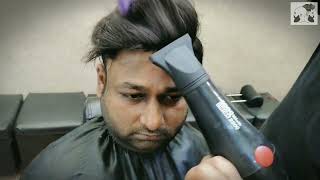7 Stages of Male Pattern Baldness
- Posted on 11 September, 2020
- Hot Topic
- By SNY Admin
Baldness is undoubtedly a condition most men will face as they progress in life. According to research, Male Pattern Baldness (MBP) can be attributed to genetic, hormonal, or age-related factors. This condition can manifest in men early (>20 years) and is characterized by the gradual loss of hair as the year goes by. Hair loss can either show up in one of the following ways;
- Slow and progressive thinning of the hair
- Circular, patchy bald spots
- Total body hair loss
- Several patches of scaling that spread all over the scalp
Many studies have shown that about two-thirds of American men experience hair loss. This number increases to about 95% by the time they get to the age of fifty. It is no wonder the demand for scalp micropigmentation for men has increased significantly over the years. There are different stages of the male baldness pattern, which we will discuss in a moment. However, it is essential to consider the different hair loss causes in male or female pattern baldness.
Causes Of Baldness
Hair loss can be detrimental to the self-esteem and confidence of an individual. Losing your hair can lead to depression and anxiety.
The following are the major causes of male hair loss patterns;
Genes (Hereditary)
The most common reason many people experience male pattern baldness is their genes. This specific condition is known as Androgenic alopecia and is common in both male and female baldness patterns. The signs are almost always predictable, and many medical professionals can tell right away if this is the reason for your hair loss.
It usually begins with a receding hairline and follows with bald spots in men.
Hormones & Medical Conditions
The next factor that is responsible for hair loss is an imbalance of hormones. The increased or decreased levels of certain hormones can lead to significant baldness (male pattern). For instance, have you ever heard the question, can creatine cause hair loss? Studies have found a connection between taking creatine and hair loss that isn’t conclusive but very difficult to ignore. Even though there is no conclusive evidence, there is a protein and hair loss connection.
Alopecia areata is also a reason for male pattern baldness. Alopecia is an autoimmune disease that causes antibodies to attack hair follicles, which leads to thinning of the hair.
Medication Side Effects
Male pattern baldness can result from taking drugs used for treating conditions such as depression, gout, high blood pressure, arthritis, etc. Radiation from chemotherapy also causes hair loss.
Process Of Hair Styling
Hairstyles that lead to excessive pulling of the hair can cause your hair to lose its texture and thin out. Whether it’s cornrows or locs, can lead to severe hair loss. Also, overexposure to heat can cause a lot of damage to your scalp and hair.
The Seven Stages Of Male Pattern Baldness (Hamilton-Norwood Scale)
The male pattern baldness stages progress slowly, and sometimes, you might not notice it until it is very severe. An excellent way to detect how severe your hair loss is and whether you might need to see a doctor is using the Hamilton-Norwood Scale. A scale created by Dr. James Hamilton in the ’50s, which explains the different stages of male hair loss as it progresses.
Although the progression rate is subjective, as individuals are different, this scale has been the standard way of ascertaining the severity of male pattern baldness.
The following are the seven stages of the Hamilton-Norwood Scale;
Stage 1
In stage 1 of the Hamilton-Norwood Scale, there is no indication of hair loss. There might be a slight thinning of the hairline’s hair or recession; however, it isn’t noticeable. Hence, it is essential to see a doctor if you have parents or siblings who have experienced hair loss. That way, you can start treatment, which will be more successful in this stage.
Stage 2
In stage 2 of the Hamilton scale, the receding hairline is more prominent on both sides of the temple. You will start to notice the M-shaped hairline many older men have as a result of baldness. Also, the hair in the middle of the scalp begins to get thinner. However, at this point, you might not notice it if you’re not observant.
Stage 3
In stage 3, there is a significant loss of hair, and you can see that you’re losing hair. This stage manifests in two different ways; the hairline might recede even further to the point that there’s no more hair on the temples. Alternatively, the hairline might remain the same, but the hair in the middle of the scalp becomes thin, leading to bald spots. This alternate manifestation of stage 3 is called stage three vertex.
Stage 4
In stage 4, the signs of baldness are apparent now. The hair on your head will be fragile, and the bald spots might become more extensive. Also, the receding hairline and M shape is even more noticeable. However, you will still have thick hair in areas of your scalp that are not affected.
Stage 5
In stage 5, the hair loss rate becomes worse, and you start to have the “horseshoe” hairline, which means you’ll be bald on top and have hair only around the sides of your head. The band of thin hair that was present in the previous stage becomes even more distinct. By this stage, treatment becomes even more difficult.
Stage 6
In stage 6, hair loss becomes even worse than in the previous stage. The band of hair separating the baldness in the temple and vertex becomes thinner. Hence, the hair present on the sides of the head starts to thin out as well.
Stage 7
By stage 7, baldness is considered complete. The horseshoe hairline is more prominent, and the little hair present on the sides of the scalp is thinner than before. Also, the top of your scalp is completely bald. To help the growth of your hair follicles in the stage is close to impossible.
Once the stages of male pattern baldness are complete, finding an effective cure becomes difficult. Hence, it is essential to ascertain your hair loss stage to improve your hair growth chances during medication.
Treatment For Male Pattern Baldness
The treatment of male pattern hair loss is usually dependent on baldness, as many medications might not work in the severe stages. Here are a few treatment options to help male pattern baldness.
Medication: Different types of hair loss medication can improve hair growth with consistent use. Minoxidil is an FDA approved topical treatment you apply to your scalp to prevent hair loss and promote regrowth. Another fantastic option is Finasteride, a pill that reduces the levels of DHT levels in the body. Unfortunately, both drugs are only as useful as you use it.
Hair Transplant: Hair transplants are usually costly; however, they are useful. Your doctor will essentially move healthy hair from the sides and back of your head to the top part. This requires a couple of procedures to be successful.
Other options include wearing a hairpiece or accepting your baldness.
Conclusion
Male pattern baldness or hair loss is prevalent and can be caused by different factors such as hereditary genes, stress, immune defects, etc. There are seven stages of male pattern baldness, and with each stage, the symptoms become worse. Although hair loss may seem permanent, by ascertaining the specific stage early, specific treatment plans can help.
Be sure to seek advice from your doctor before taking any medication.
Frequently Asked Questions
Can Male Pattern Baldness Be Stopped?
Male pattern baldness or hair loss cannot be stopped. However, with medications like Minoxidil and Finasteride, you can slow down the process and grow your hair
At What Age Does Male Pattern Baldness Stop?
There is no specific age when male pattern baldness will stop. Hair loss usually doesn’t depend on your age; however, there are medications to help you reduce the effects of male baldness and hair loss.




